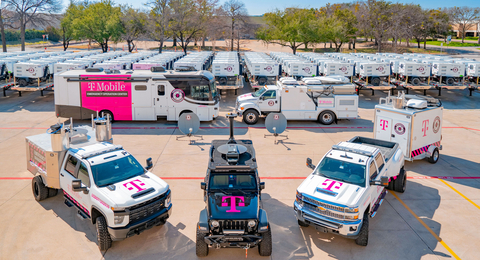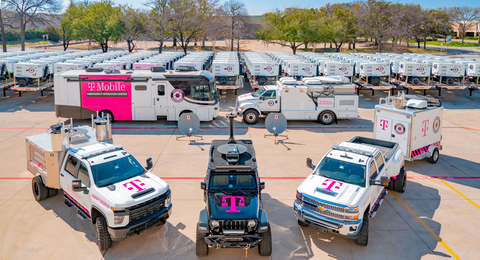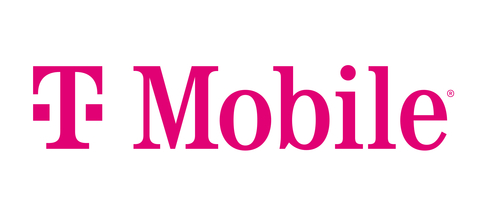BELLEVUE, Wash.--(BUSINESS WIRE)--With hurricane season starting this week and wildfire season already here, T-Mobile (NASDAQ:TMUS) is ready to help make sure customers, communities, businesses, first responders, government agencies and others can reach the people they care about, get the information they need and stay connected when it matters most.
“At T-Mobile, we understand the vital role we have in keeping people connected during challenging times, so we continue to expand coverage and capacity, invest in network resilience and evolve our approach to disaster response to be ready to respond when we’re needed,” said Ulf Ewaldsson, president of technology at T-Mobile. “Connectivity is a lifeline in a crisis, so we’ve increased training, added more vehicles and further built our network. Our priority is to ensure everyone who needs connectivity has it — from families to public safety and first responders. We’ll be ready.”
With some researchers predicting a record-breaking hurricane season and above normal risks for wildfires for some portions of the country this year, T-Mobile has taken significant steps to further prepare its network, teams and resources, including:
- Turning on new 2.5 GHz spectrum to boost critical coverage and capacity for nearly 60 million customers throughout the country, including hurricane-prone areas such as Louisiana.
- Continuing to harden its network with permanent backup power solutions like generators and batteries.
- Launching a Community Support Advocates Program that provides specialized disaster response and recovery training for T-Mobile employees looking to support on the frontlines.
- Adding brand-new XL SatCOLTs (Satellite Cell-On-Light-Trucks) and XL SatCOWs (Satellite Cell-On-Wheels) — T-Mobile’s largest disaster response network vehicles yet — later this year.
- Increasing its vehicle fleet of network SatCOLTs and SatCOWs, as well as heavy-duty trucks to provide Wi-Fi and device charging.
“In times of crisis, T-Mobile is ready to show up for our customers and our communities and take action to help in recovery where it is most needed,” said Jon Freier, consumer group president at T-Mobile. “Our teams will be on the ground, ready to offer our hands and hearts in times of need and ensure that we’re there to support as best we can through the toughest of challenges.”
Network Hardening and Resilience
Since last year’s hurricane season, T-Mobile has continued to harden its network with permanent backup power solutions like generators and batteries to help ensure that when disasters strike, key sites and overlapping coverage keep customers connected. T-Mobile also recently turned on its new 2.5 GHz spectrum, which improved coverage and capacity for nearly 60 million customers across the country.
T-Mobile also continuously enhances its nationwide infrastructure — including towers, cell sites, network switches, data centers and other critical sites — to improve reliability and resilience in urban and rural areas alike. Technicians and engineers at T-Mobile’s National Operations Centers (NOCs) monitor and manage the network 24/7 and when demand increases, they can remotely concentrate the signal giving first responders more bandwidth for data-intensive activities such as orchestrating rescues.
Disaster Response Solutions
When disasters strike, T-Mobile deploys resources to boost and restore coverage, recover from commercial power outages and deliver connectivity to those in need across the U.S. In the last three years, T-Mobile increased its fleet of network emergency response assets and vehicles by 2.4 times, adding SatCOLTs, SatCOWs and more. In the same timeframe, the Un-carrier added more Network Emergency Operations Center Class A Recreational Vehicles (RVs), Community Support Command Center Class C RVs and heavy-duty command center trailers for on-site operations, network and support management; agile VSATs (Very Small Aperture Terminals) for quick-deploy satellite backhaul; and heavy-duty Wi-Fi and charging trucks and trailers.
Later this year T-Mobile will introduce its largest network disaster response vehicles to date — XL SatCOLTs and XL SatCOWs. These massive, heavy-duty network response vehicles will supplement coverage and restore connectivity through satellite and microwave backhaul. They will be outfitted with the latest 5G hardware to operate across a much wider coverage footprint and provide nearly the same level of service as one of T-Mobile’s macro cell sites.
Supporting Communities, First Responders and Government Agencies
T-Mobile recently introduced the Community Support Advocates Program (CSAP), which offers specialized training in the Un-carrier’s disaster response protocols for employees looking to support on the frontlines during a disaster. CSAP team members will then deploy bringing device charging, supplies and Wi-Fi to communities affected by disasters.
Throughout the year, T-Mobile’s emergency response teams participate in exercises and training to refine their skills and strengthen disaster response strategies. T-Mobile collaborates with government organizations, first responder agencies, public utilities and other wireless providers drawing lessons from previous disasters to improve future response and restoration efforts. Emergency teams also join industry events to engage with disaster response experts, like at the Governor’s Hurricane Conference and U.S. Chamber of Commerce Building Resilience Conference.
During disasters, T-Mobile collaborates with local governments’ Emergency Operations Centers to provide network services, establish connectivity and prioritize restoration efforts to local, state and federal agencies, first responders, medical teams and others when it’s most needed.
First responders, emergency officials and other eligible critical infrastructure customers can register for Wireless Priority Service (WPS) to get priority access and preemption on T-Mobile’s network at no cost. When seconds matter during times of emergency or network congestion, WPS moves critical communications to the front of the line.
For more information on how T-Mobile prepares for and responds to disasters, visit T-Mobile’s Emergency Response Hub.
Follow @TMobileNews on X, formerly known as Twitter, to stay up to date with the latest company news.
See 5G device, coverage, & access details at T-Mobile.com.
About T-Mobile
T-Mobile US, Inc. (NASDAQ: TMUS) is America’s supercharged Un-carrier, delivering an advanced 4G LTE and transformative nationwide 5G network that will offer reliable connectivity for all. T-Mobile’s customers benefit from its unmatched combination of value and quality, unwavering obsession with offering them the best possible service experience and undisputable drive for disruption that creates competition and innovation in wireless and beyond. Based in Bellevue, Wash., T-Mobile provides services through its subsidiaries and operates its flagship brands, T-Mobile, Metro by T-Mobile and Mint Mobile. For more information please visit: https://www.t-mobile.com.





